#5 gigabit
Explore tagged Tumblr posts
Text
have I got some holes for y’all :3





anyone want pics of my holes?
#listen he’s a little bit older#but he’s got all the right stuff#still my main when I’m away from my desk#2013 Dell Precision M4700#6-core Core i7 Extreme w/ 24 GB of RAM and nVidia Quadro dGPU#runs up to W10 officially but runs 11 flawlessly w/ the workaround#and was only passed up because Ivy Bridge is too old to meet the hardware security requirements for 11#not because of any performance issues at all#outside of gaming#this still paces with T modern i7 and RTX-equipped desktop#and it’s got HOLES!!#5 USB ports!! still has a 1394 FireWire!! dedicated headphone/headset/line out and dedicated mic/line in!!#express card and sd card !!#a swappable optical bay that can be upgraded to a blu-ray drive or another internal SATA drive!! for up to 3 SSDs!!#full size display port full size hdmi and full size vga !!!#Gigabit Ethernet networking and the eSATA for an additional storage solution!!!#a removable battery that can be swapped while charging!!!#a docking connector to add a dock (duh) or port replicator and desktopify this beast w/ more I/O!!!#and the main 2.5-inch SATA bay can easily swapped for added storage w/ 2 screws!!#supports M.2 for main SSD!!#idk what standard of PCIe but yes it is modern PCIe as well!!#has a socketed processor and GPU and network card and 4 slots for RAM!!!#HOLES HOLES HOLES !!!!!!’#AND HARDWARE RADIOS SWITCH MY BELOVED#it will kill wireless radios with a simple click!!#I LOVE WORKSTATION LAPTOP AND PROFESSIONAL GRADE COMPUTERS AND OLDER HARDWARE THATS SERVICEABLE AND UPGRADABLE!!!#did I forget to mention the entire bottom panel comes off in one easy piece with a couple screws and everything is accessible??
28K notes
·
View notes
Text
Ozark Fiber Is Bringing High-Speed Fiber Internet To Republic, MO

Ozark Fiber is embarking on an ambitious project to revolutionize communication in Republic, Missouri. With construction already underway, the company is set to deploy cutting-edge high-speed fiber-optic communications in a phased approach. The first areas will be serviceable as early as Q1 2024, with the majority of the city limits expected to have access to this advanced technology by Q4 2024.
This endeavor carries significant economic and infrastructural implications for the city. David Cameron, City Administrator for the City of Republic, expressed the city's commitment to fostering economic growth and modern infrastructure through this initiative. He noted that Ozark Fiber's introduction of fiber internet, WiFi, and voice solutions would not only attract new investments but also elevate the overall infrastructure of the city.
Jason Ross, President of Ozark Fiber, echoed this sentiment, emphasizing the company's excitement in bringing cutting-edge technology to Republic. What sets Ozark Fiber apart is not only its speed and reliability compared to traditional cable offerings but also its unwavering dedication to superior customer experience. Their approach is straightforward, with no gimmicks, a simple pricing model, no data caps, no contracts, and affordable rates. The decision to invest in Republic is a direct reflection of the city's proactive mission.
Read More - https://bit.ly/3Ph7cYn
0 notes
Text
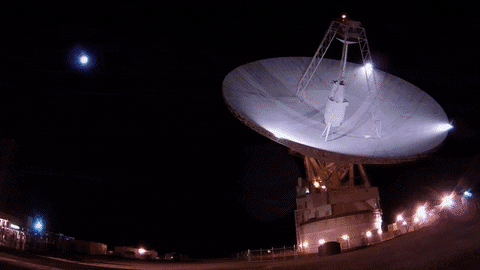
9 Out-of-This-World Moments for Space Communications & Navigation in 2023
How do astronauts and spacecraft communicate with Earth?
By using relay satellites and giant antennas around the globe! These tools are crucial to NASA’s space communications networks: the Near Space Network and the Deep Space Network, which bring back science and exploration data every day.
It’s been a great year for our space communications and navigation community, who work to maintain the networks and enhance NASA’s capabilities. Keep scrolling to learn more about our top nine moments.
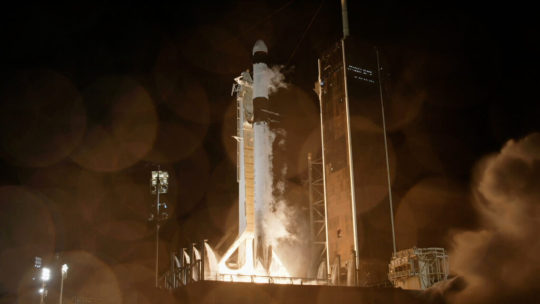
The SpaceX Falcon 9 rocket carrying the Dragon spacecraft lifts off from Launch Complex 39A at NASA's Kennedy Space Center in Florida on Thursday, Nov. 9, 2023, on the company's 29th commercial resupply services mission for the agency to the International Space Station. Liftoff was at 8:28 p.m. EST.
1. In November, we launched a laser communications payload, known as ILLUMA-T, to the International Space Station. Now, ILLUMA-T and the Laser Communications Relay Demonstration (LCRD) are exchanging data and officially complete NASA’s first two-way, end-to-end laser relay system. Laser communications can send more data at once than traditional radio wave systems – think upgrading from dial-up to fiber optic internet. ILLUMA-T and LCRD are chatting at 1.2 gigabits per second (Gbps). At that rate, you could download an average movie in under a minute.
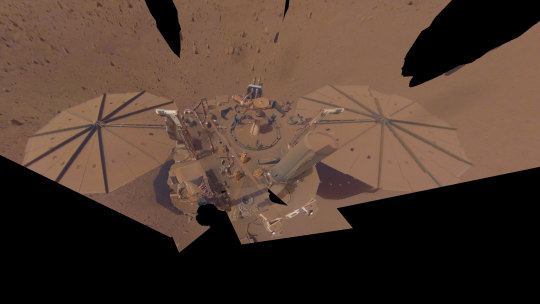
NASA’s InSight lander captured this selfie on Mars on April 24, 2022, the 1,211th Martian day, or sol, of the mission.
2. Data analyzed in 2023 from NASA’s retired InSight Mars lander provided new details about how fast the Red Planet rotates and how much it wobbles. Scientists leveraged InSight’s advanced radio technology, upgrades to the Deep Space Network, and radio signals to determine that Mars’ spin rate is increasing, while making the most precise measurements ever of Mars’ rotation.
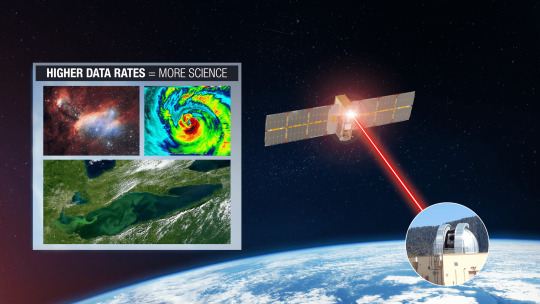
TBIRD is demonstrating a direct-to-Earth laser communications link from low Earth orbit to a ground station on Earth.
3. We set a new high record! The TeraByte InfraRed Delivery (TBIRD) payload – also demonstrating laser communications like ILLUMA-T and LCRD – downlinked 4.8 terabytes of data at 200 Gbps in a single 5-minute pass. This is the highest data rate ever achieved by laser communications technology. To put it in perspective a single terabyte is the equivalent of about 500 hours of high-definition video.
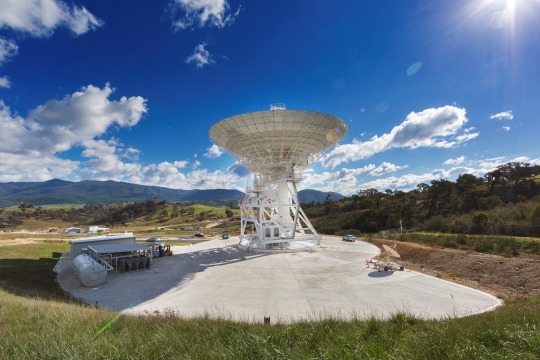
A 34-meter (112-foot) wide antenna at Canberra Deep Space Communications Complex near Canberra, Australia.
4. This year we celebrated the Deep Space Network’s 60th anniversary. This international array of antennas located at three complexes in California, Spain, and Australia allow us to communicate with spacecraft at the Moon and beyond. Learn more about the Deep Space Network’s legacy and future advancements.
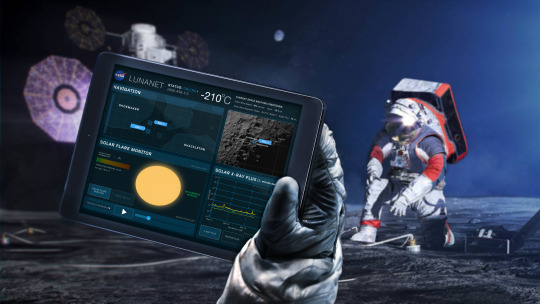
An illustration of the LunaNet architecture. LunaNet will bring internet-like services to the Moon.
5. We are bringing humans to the Moon with Artemis missions. During expeditions, astronauts exploring the surface are going to need internet-like capabilities to talk to mission control, understand their routes, and ensure overall safety. The space comm and nav group is working with international partners and commercial companies to develop LunaNet, and in 2023, the team released Draft LunaNet Specification Version 5, furthering development.
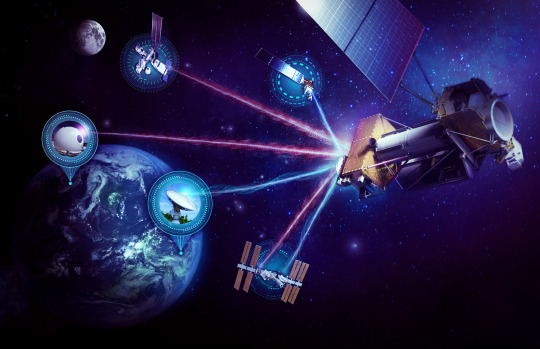
The High-Rate Delay Tolerant Networking node launched to the International Space Station in November and will act as a high-speed path for data.
6. In addition to laser communications, ILLUMA-T on the International Space Station is also demonstrating high-rate delay/disruption tolerant networking (HDTN). The networking node is showcasing a high-speed data path and a store-and-forward technique. HDTN ensures data reaches its final destination and isn’t lost on its path due to a disruption or delay, which are frequent in the space environment.

The Communications Services Project (CSP) partners with commercial industry to provide networking options for future spaceflight missions.
7. The space comm and nav team is embracing the growing aerospace industry by partnering with commercial companies to provide multiple networking options for science and exploration missions. Throughout 2023, our commercialization groups engaged with over 110 companies through events, one-on-one meetings, forums, conferences, and more. Over the next decade, NASA plans to transition near-Earth services from government assets to commercial infrastructure.
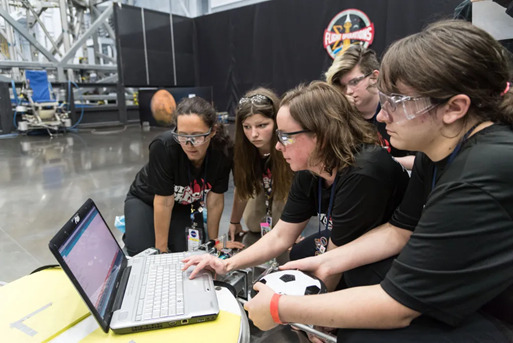
Middle and high school students solve a coding experiment during NASA's Office of STEM Engagement App Development Challenge.
8. Every year, NASA’s Office of STEM Engagement sponsors the App Development Challenge, wherein middle and high school students must solve a coding challenge. This year, student groups coded an application to visualize the Moon’s South Pole region and display information for navigating the Moon’s surface. Our space communications and navigation experts judged and interviewed students about their projects and the top teams visited NASA’s Johnson Space Center in Houston!
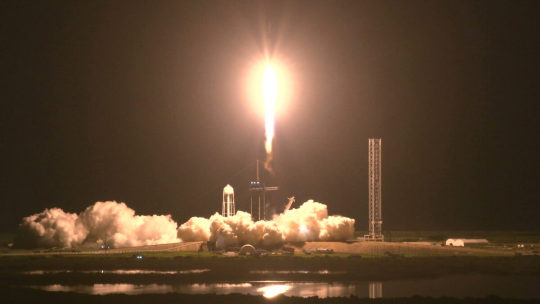
A SpaceX Falcon 9 rocket soars upward after liftoff at the pad at 3:27 a.m. EDT on Saturday, Aug. 26, from Kennedy Space Center’s Launch Complex 39A in Florida carrying NASA’s SpaceX Crew-7 crew members to the International Space Station. Aboard SpaceX’s Dragon spacecraft are NASA astronaut Jasmin Moghbeli, ESA (European Space Agency) astronaut Andreas Mogensen, JAXA (Japan Aerospace Exploration Agency) astronaut Satoshi Furukawa, and Roscosmos cosmonaut Konstantin Borisov.
9. The Near Space Network supported 19 launches in 2023! Launches included Commercial Crew flights to the International Space Station, science mission launches like XRISM and the SuperBIT balloon, and many more. Once in orbit, these satellites use Near Space Network antennas and relays to send their critical data to Earth. In 2023, the Near Space Network provided over 10 million minutes of communications support to missions in space.
Here’s to another year connecting Earth and space.
Make sure to follow us on Tumblr for your regular dose of space!
1K notes
·
View notes
Text
1. Girl with incurable cancer recovers after pioneering treatment

A girl’s incurable cancer has been cleared from her body after what scientists have described as the most sophisticated cell engineering to date. Alyssa, whose family do not wish to give their surname, was diagnosed with T-cell acute lymphoblastic leukaemia in May 2021.
Scientists at Great Ormond Street Hospital for Children in London gave her pre-manufactured cells edited using new technology to allow them to hunt down and destroy cancerous T-cells without attacking each other. Less than a month after being given the treatment, she was in remission, and was able to have a second bone marrow transplant.
Can I get a fuck cancer?
2. The UK has made gigabit internet a legal requirement for new homes
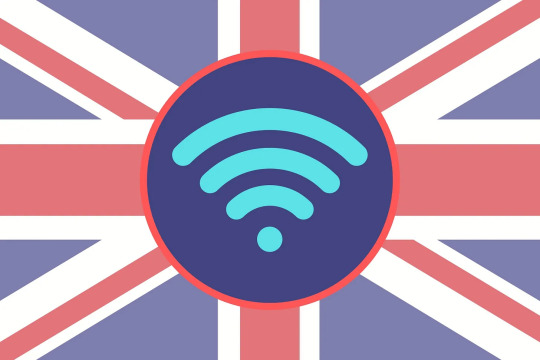
Updated regulations require new properties to be built with gigabit broadband connections and make it easier to install into existing blocks of flats across the UK. Connection costs will be capped at £2,000 per home, and developers must still install gigabit-ready infrastructure (including ducts, chambers, and termination points) and the fastest-available connection if they’re unable to secure a gigabit connection within the cost cap
3. US cancer death rate falls 33% since 1991

The rate of people dying from cancer in the United States has continuously declined over the past three decades, according to a new report from the American Cancer Society.
The US cancer death rate has fallen 33% since 1991, which corresponds to an estimated 3.8 million deaths averted, according to the report, published Thursday in CA: A Cancer Journal for Clinicians. Partly due to advances in treatment, early detection and less smoking, report says
. . .
Thank you for following. You can support this newsletter for less than a price of a cup of coffee:
Support with a coffee ❤️
Let’s continue with the good news…
. . .
4. Lab-grown retinal eye cells make successful connections, open door for clinical trials to treat blindness

Retinal cells grown from stem cells can reach out and connect with neighbors, according to a new study, completing a “handshake” that may show the cells are ready for trials in humans with degenerative eye disorders.
Over a decade ago, researchers from the University of Wisconsin–Madison developed a way to grow organized clusters of cells, called organoids, that resemble the retina, the light-sensitive tissue at the back of the eye. They coaxed human skin cells reprogrammed to act as stem cells to develop into layers of several types of retinal cells that sense light and ultimately transmit what we see to the brain.
5. The ozone layer is on track to recover in the next 40 years, the United Nations says

The Earth's ozone layer is on its way to recovering, thanks to decades of work to get rid of ozone-damaging chemicals, a panel of international experts backed by the United Nations has found.
The ozone layer serves an important function for living things on Earth. This shield in the stratosphere protects humans and the environment from harmful levels of the sun's ultraviolet radiation. In the latest report on the progress of the Montreal Protocol, the U.N.-backed panel confirmed that nearly 99% of banned ozone-depleting substances have been phased out.
6. Uganda declares an end to Ebola outbreak

The Ugandan government has declared an end to its Ebola outbreak, less than four months after cases were first reported. Since 20 September, 56 people have died from the virus, which is spread through body fluids, and there have been 142 confirmed infections.
The country has reported no new infections in more than 42 days – twice the maximum incubation period of the virus, a World Health Organization benchmark for a country to be declared Ebola-free.
7. Doggy ‘daycare’ bus in Alaska goes viral on TikTok
Check them out here:
- - -
That's it for this week. If you liked this post you can support this newsletter with a small kofi donation:
Buy me a coffee ❤️
Subscribe for more weekly wholesome news...
468 notes
·
View notes
Text


Record-breaking laser demonstration completes mission
NASA's TBIRD (TeraByte InfraRed Delivery) demonstration and its host spacecraft—the PTD-3 (Pathfinder Technology Demonstrator-3)—have completed their technology demonstration. The TBIRD payload spent the past two years breaking world records for the fastest satellite downlink from space using laser communications.
NASA's PTD series leverages a common commercial spacecraft to provide a robust platform for effective testing of technologies with minimal redesign in between launches. After launch in May 2022 on the SpaceX Transporter 5 mission, the PTD-3 spacecraft entered low-Earth orbit, and shortly after, TBIRD began sending laser communications signals to an optical ground station in Table Mountain, California.
TBIRD's two-year demonstration showcased the viability of laser communications. Most NASA missions rely on radio frequency communication systems. However, laser communications use infrared light and can pack significantly more data in a single communications link. This technology is ideal for science and exploration missions that need large data transmissions.
In 2023, TBIRD continuously broke its own records, reaching its peak in June when it transmitted 4.8 terabytes of error-free data—equivalent to about 2,400 hours of high-definition video—in five minutes at 200 gigabits per second in a single pass.
The TBIRD payload was one of many laser communications demonstrations. NASA's SCaN (Space Communications and Navigation) program is maturing this technology to demonstrate the impact laser communications can have on bringing more science and exploration data home. The next demonstration will be on the Artemis II mission.
In addition to breaking a world record, this mission demonstrated cost-effective design and extremely low size, weight, and power requirements—both on the PTD-3 spacecraft and within the TBIRD payload. The tissue-box-sized payload contained two commercial telecommunication modems that the TBIRD team modified for the extreme environment of space.
The PTD-3/TBIRD system also overcame one of the major challenges associated with laser communications: making the narrow beam laser link connection while moving at orbital speeds while being buffeted by atmospheric drag. The PTD-3 spacecraft's precision "body pointing" and stability enabled the TBIRD payload to make its record-breaking achievement while moving as fast as 17,000 mph through space. The spacecraft set a record for the highest accuracy pointing ever achieved by a NASA CubeSat without any moving mechanisms or propulsion systems.
The end of PTD-3 and TBIRD's mission was expected. The system did not contain a propulsion system, meaning once it was deployed into its low Earth orbit, the mission could only last until its orbit naturally decayed.
While only planned to operate for six months, TBIRD carried out its demonstration for well over two years, enabling NASA to learn more about laser communications operations in low Earth orbit.
The lessons learned during TBIRD will be applied to future implementations of laser communications and minimize downlink constraints for mission designs, enabling future exploration and discoveries.
TOP IMAGE: The benefits of laser communications: more efficient, lighter systems, increased security, and more flexible ground systems. Credit: NASA/Dave Ryan
LOWER IMAGE: An artist’s concept of the Pathfinder Technology Demonstration -3 carrying the TeraByte InfraRed Delivery payload. Credit: NASA/Dave Ryan
3 notes
·
View notes
Text
Sims is a trap actually, you will spent like 20 hours downloading mods and cc, to spend like 4 hours in CAS and 10 hours building a house, 1 hour of gameplay in 48 hours and then you realise that it takes 50 gigabites of space and almost getting an insult you delete it. And want to play like next 5 months after.
This is not a game, this is like getting into drugs and being in recess cycle.
2 notes
·
View notes
Text
I remember about 5 years ago I had a 20 megabit internet connection and it felt plenty fast and I never rlly questioned it. It worked great! That’s megaBIT, as in about 1.5 megabyte per second. This would be considered glacially slow by most today. Then a year later* I upgraded to a 150 megabit connection and my mind was blown!! I distinctly remember texting my friend “nobody needs speeds this fast”. I could illegally download sooooo much anime in a fraction of the time…
Now I have Gigabit (50x the original 20 megabit speeds) and yes it’s fast but I feel like it’s…. Under-utilized? My connection is fast and most stuff downloads in a snap, and I’ve never had to download something “overnight” as I used to regularly do and for some reason that feels like a loss to me. My connection is fast but I feel like it sits idle most of the time, whereas previously my connection used to be going 24/7, always had a few downloads or uploads queued up. It’s a lot more quiet now and I think that old text is still kinda true.
*: unrelated to pandemic, I destroyed my old WRT54G router and got a new one and decided to upgrade my wifi with it
2 notes
·
View notes
Note
alright Specs give me a lesson on WiFi Standards
I can't wait to see the brilliance you'll share<3
-anon
Interesting choice, as this is the less interesting option. But if you insist /nm
You've most likely heard of Wifi 5 or Wifi 6, maybe even wondered about Wifis 1, 2, 3, and 4. In the fancy IT speak, these are lumped together with the number 802.11 (eight oh two dot eleven). There are a lot of them, but the ones that made the press are 802.11a, b, g, n, ac, and ax. All but n, ac, and ax are out of date, with n on the way out.
802.11a and 802.11b are sister standards. But I suppose first I need to say that Wifi communicates on a frequency of either 2.4 gigahertz or 5 GHz. The best way to think of these frequencies is like radio stations - each station is called a channel. There are a lot more non-overlapping channels at the 5 GHz range (non overlapping reduces noise and signal degradation), but the US government uses them so your signal gets less priority over, say, air traffic controllers. 2.4 GHz has fewer overlapping channels, but you're not fighting the government. As I recall, 5 GHz travels farther, but that isn't always necessary. If you're sitting right next to the router, for example, you don't need such a strong signal to get to your internet box.
802.11b was released shortly before 802.11a, and it is b that took hold. Once I give the numbers, you may find that confusing. 802.11a can transmit at a speed of 54 megabits per second in the 5 GHz frequency. 802.11b transmitted at 11 mbps in the 2.4 GHz frequency. Slower, but at a different frequency. So why did b win out? Because it got there first and was a lot cheaper than 802.11a.
5 years later, in 2003, 802.11g was ratified. It transmits at 54 mbps on the 2.4 GHz frequency. Because it's at that frequency, a device that is set for 802.11b - an older device, by definition - can communicate on an 802.11g network, and vice versa. The only problem is that the slowest device sets the speed, so it doesn't matter how great your network is - if your device can't take the speed, you're not going to get it. 802.11g also uses a different "language" to encode signals, in addition to the one that 802.11b uses. Since b can't understand the one that g uses, b devices can't tell if the router is busy, so the signals could get mixed up. This is solved again by, the slowest device sets the speed. The access point will revert to the language b understands, and ALL devices connected to it won't go any faster than 11 mbps. Not ideal, but reduces costs when a network is updated. So network administrators can choose either faster devices at a greater upfront cost, or spread that cost over a few years but suffer overall slow speed across the network.
We stuck with g for a good long while before 802.11n was introduced, under the name Wifi 4. 802.11n transmits at 600 mbps in theory, 300-450 in practice, at both 2.4 GHz and 5 GHz, which means it's backwards compatible with 802.11a, b, and g. It gets that speed by being able to transmit more than one signal at a time, through a thing called MIMO (multiple in, multiple out - I say "meemo" but "my mo" is also acceptable.) That's mostly a fancy way of saying there are more antenna on an access point than just one. An 802.11n device can support up to eight antennas, with four going in and four going out.
In 2014, 802.11ac, or Wifi 5, was released, and was the first standard that used Gigabit ethernet. 802.11ac transmits at 6.9 gigabits per second (nice) in theory, 1.3 in practice, at 5 GHz. ac doubles the amount of antenna, and also lets up to four devices transmit on each antenna at a time. It also has a fancy little thing called beamforming, which means the signal goes in a straight line to the device, instead of being broadcast everywhich way.
Wifi 6, or 802.11ax, was released in 2019, and is still making its way across the world. 802.11ax goes at a max speed of 9.6 gbps at both 2.4 GHz and 5 GHz. It also uses another encoding language, which means any devices on 802.11b, if those senior citizens are still around, are SOL. Which is fine - let grandpa rest. 802.11ax lets more devices connect to the router at once, and lets more devices transmit at once.
You regret choosing this one now, don't you. I much would have preferred to talk about motherboard connections - I don't have to have a textbook next to me for that.
2 notes
·
View notes
Text
ACEMAGIC AMR5 AMD Ryzen 7 mini pc with Radeon graphics
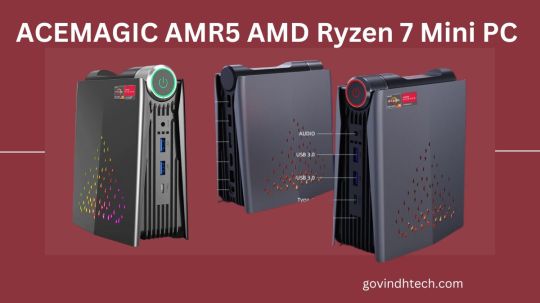
ACEMAGIC AMR5 AMD Ryzen
ACEMAGIC AMR5 AMD Ryzen 7 Mini PC An extremely small PC with the Ace Magic AMR5 based on an AMD Ryzen 7 5700U is available from Mini pc Union. The AMR 5 differs from the typical design of most Mini PCs in that it has a more desktop PC-like appearance. See what this little PC can do in our in-depth study by reading on.
The ACEMAGIC AMR5 Mini PC, the Most Versatile Mini PC, transforms any desk into a productive workstation. To initiate creation, code, and collaborate, all you need is a monitor, keyboard, mouse, or trackpad.
AMD Radeon Graphics accelerates games without sacrificing visual quality. Increase the resolution and settings to have an even better visual experience. Triple 4K@60Hz displays with simultaneous display to meet all of your task needs.
ACEMAGIC AMR5 AMD Ryzen 7 5700U Mini PC Particular Features of the ACEMAGIC AMR5 Mini Computer In search of further information? These are what they are! The ACEMAGIC AMR5 has an amazing list of features:
AMD Ryzen 7 5700U chip: This Gaming Mini PC offers unmatched gaming and multitasking performance by using the power of Ryzen’s state-of-the-art chip. Memory and Storage Options: Packed with either a mammoth 16GB DDR RAM paired with a massive 1TB SSD and Wi-Fi 6, or a blazing fast 512GB SSD with WiFi 5.2, this device ensures lightning-quick data access and flawless communication. An abundance of connectivity Experience the ease of Dual Gigabit Ethernet, which guarantees dependable and fast internet connections for seamless work or gaming. Dual Screen 4K Display: Take in breathtaking images and improve your gaming or work setup with support for two 4K screens. Effective Heat Dissipation: The magnetically removable case design of the ACEMAGIC AMR5 AMD Ryzen 7 Mini PC provides effective heat dissipation, which keeps the system cool even during long gaming sessions. Entire USB All-in-One 4.0 Construct Your Own with Upgradable Architecture Innovative Design for Heat Dissipation
Comprehensive Specification Information
Graphics and Processor The AMD Ryzen 7 5700U CPU, a wonder of modern technology that bursts performance and efficiency barriers, is the engine that powers the Pre Built Mini Gaming PC. This CPU unleashes a speed symphony, igniting every command with lightning-fast speed and sending your gaming adventures to new heights. But the enchantment doesn’t end there.
AMD Radeon Graphics
Enhanced by the Ryzen UHD Graphics, this dynamic pair creates an immersive spectacle in which brilliant colors bring every pixel to life, transporting you to a realm where game and reality coexist together. Get ready for an encounter when the gaming Mini PC’s accuracy and power collide.
Storage and Memory For the ACEMAGIC AMR5 AMD Ryzen 7 Mini PC, choose from two excellent options, each designed to improve your experience. Select the 16GB DDR RAM and large 512GB SSD with WiFi 5.2, which offers lightning-fast speed and flawless connection while supporting all of your gaming needs. Instead, treat yourself to the 32GB DDR RAM and a large 512GB SSD, together with the state-of-the-art WiFi 6 for unmatched storage and improved connection.
Depending on your needs, you can choose between two configurations for the Mini Gaming PC with Graphics Card that will revolutionize your gaming experience and perfectly meet your needs for either large storage or state-of-the-art networking.
Interaction With the smooth connection and unmatched performance that this Best Gaming Mini PC offers, celebrate the new year! Equipped with two Gigabit Ethernet connections and cutting-edge WiFi technologies, it is designed to surpass limits in terms of communication. You may fully immerse yourself in game environments without experiencing any delays or interruptions.
Free Shipping From US Warehouse: ACEMAGIC makes this offer even more alluring by providing free shipping wherever in the globe, regardless of where you are.
Presentation and Style With support for two 4K screens, the ACEMAGIC Pre Built Mini Gaming PC completely transforms your visual experience and increases immersion to never-before-seen heights. There’s more to this miracle, however. Accept the cutting-edge magnetic detachable case design, which guarantees effective heat dissipation in addition to adding a stylish touch.
This architecture prevents the device from overheating, even during the most strenuous gaming sessions. Take advantage of the opportunity to improve your visual adventures while taking advantage of a bargain that inspires creativity and delight in every pixel.
Read more on Govindhtech.com
2 notes
·
View notes
Note
i think it should be illegal for landlords to have anything to do with home networking, nothing between tenants and their ISP. i had one landlord who, when we got fibre installed, added a network cable through the walls so we could plug our router in upstairs instead of in the downstairs entryway where the fibre connection came in. great! except he found some network cable that capped out at about 50Mbit/s over 15-20m or so. so about 5% of the gigabit plan we had.
i think it should be illegal for landlords. full stop. period.
all my utilities are included in rent (part of why i was able to afford this place back when i moved in), so it's my landlord's name on the internet bill. also i don't think we have any legal say in what type of smoke alarms are used (as long as the landlord ensures they meet regulations on the amount and placement), which means even if i did choose my ISP and set the router up myself i could still be forced to use all the smart home stuff if the landlord put nest smart alarms in the property. which they have. but they also sorted the networking. and the flat is rented as individual flats w/ communal areas (kitchen, bathrooms etc.) rather than a big flat w/ multiple bedrooms if that make sense and since the router is in the communal area (and would affect other tenants) i'm pretty sure touching it would be a breach of contract. so like there's multiple ways in which it's all fucked and you're so right. but it's not a situation that can be avoided or changed until i can move elsewhere :c
also that's fucked like obviously they picked the cheapest cable that had the right connectors on it and ignored the rated speed bc hey it's not their problem (though if you were paying for gigabit separate to your rent and an action on your landlord's part caused you to not get that full speed, there may have been recourse to challenge them about it ? depends on what was in your contract).
another thing our landlord did is whenever there's an issue that we report and they (eventually) fix, they then like to micromanage us as tenants for the next couple weeks. we got told one of the kitchen table was too messy (it had clean pots and pans on it bc of a lack of suitable storage space), given a week to move stuff off or it would all get chucked. they actually came in and took everything off that table. which i'm pretty sure is illegal. and then promised us new cupboards or something to help w/ the storage issue. and it's been months. no new cupboards. this shit only happens whenever they have to come fix a door hinge or the boiler etc. like some sort of punishment for telling them the flat we pay them to live in is falling apart. for having to do the one job they actually have. that they don't even have to do bc they call in contractors to do it.
anyway, yeah fuck landlord and fuck them controlling stuff in the property you're paying to live in. also i had no idea about all the smart home stuff until i moved in. it's not really pointed out during the viewing. and nest are especially bad bc those devices recently had some sort of voice command feature unlock, meaning they were built w/ microphones this whole time which was never disclosed until the voice command feature dropped.
rant over lmao i'm hoping to move in a year, maybe two years depending on what's available and for how much
5 notes
·
View notes
Text
Which SBCs are best for your DIY projects
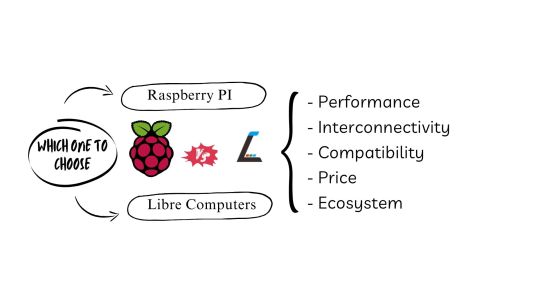
In the world of DIY electronics and embedded system projects, single-board computers (SBCs) reign supreme. Among the top contenders, the Raspberry Pi and the Libre Computer Board stand tall, each offering a unique set of features and capabilities. In this blog, we embark on a technical journey to compare these two titans, helping you make the perfect choice for your next DIY endeavour.
1. Efficiency: Raspberry Pi and Libre Computer Boards Go Head to Head
The Raspberry Pi boasts a reputation for dependability and robust performance, thanks to its Broadcom CPU. With models ranging from quad-core ARM Cortex-A53 to quad-core Cortex-A72, it's a versatile choice for a wide spectrum of applications. The Raspberry Pi 4, in particular, shines with its powerful CPU and GPU performance.
Libre Computer Boards, on the other hand, come in various models and CPU architectures, including ARM Cortex-A53 and Cortex-A72. These boards offer competitive performance and often provide more RAM options than their Raspberry Pi counterparts.
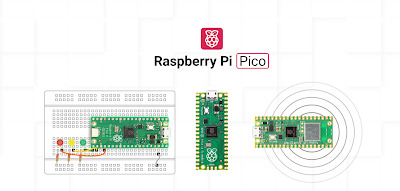
2. Capabilities of the GPU: Graphics Galore
Raspberry Pi models are equipped with Broadcom VideoCore GPUs, optimized for multimedia applications, making them perfect for video playback, gaming, and graphics-rich projects.
Libre Computer Boards offer ARM Mali GPUs in some models, delivering excellent graphics performance. What's more, certain models support GPU acceleration for machine learning tasks, making them a top choice for AI and computer vision projects.
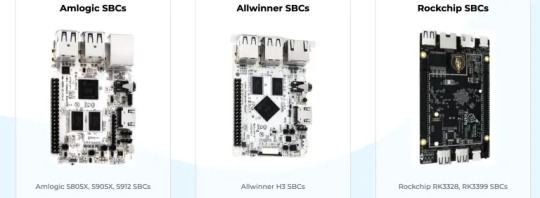
3. Interconnectivity: Ports, Pins, and More
Raspberry Pi boards come well-connected, featuring multiple USB ports, Ethernet, HDMI, and GPIO pins. The Raspberry Pi 4 even boasts a USB-C port for charging and supports dual-monitor setups via micro HDMI ports.
Libre Computer Boards offer a similar array of connectivity options, including USB 3.0 ports, Gigabit Ethernet, and HDMI. Some models, like the Tritium H5, sweeten the deal with eMMC storage for faster data access.
4. Operating System Compatibility: The Heart of the Machine
Raspberry Pi shines with its extensive community support and an extensive library of compatible software. Raspbian (now Raspberry Pi OS) is a highly optimized Linux distribution tailored specifically for Raspberry Pi devices, offering user-friendliness ideal for beginners.
Libre Computer Boards, while capable of running various Linux-based operating systems, may have more limited community support compared to the Raspberry Pi.
5. Price Wars: Budgeting for Brilliance
Raspberry Pi remains an unbeatable value, offering affordable options like the Raspberry Pi Zero and the Raspberry Pi 3A+. Even the higher-end Raspberry Pi 4 remains budget-friendly.
Libre Computer Boards, while slightly pricier than their Raspberry Pi counterparts, often pack additional features and better hardware specs, making them a compelling choice for enthusiasts.
6. The Ecosystem and the Community: Strength in Numbers
The Raspberry Pi boasts a vast and active community, resulting in an abundance of documentation, tutorials, and third-party accessories. This makes it an excellent starting point, especially for newcomers.
While the Libre Computer Boards community is growing steadily, it may not rival the sheer size of the Raspberry Pi community. However, if you're experienced with SBCs, this might not be a deal-breaker.
7. Unique Features: Tailored to Your Needs
Raspberry Pi stands out with specialized add-ons like the Raspberry Pi Camera Module for photography and video projects and the Raspberry Pi Pico for microcontroller applications.
Some Libre Computer Boards bring unique features to the table, such as the ROC-RK3328-CC with PCIe support, allowing you to integrate custom hardware components seamlessly.
Conclusion: Finding Your Perfect SBC Match
Choosing between a Raspberry Pi and a Libre Computer Board hinges on your project requirements and your familiarity with single-board computers.
For beginners and those seeking a vast ecosystem, the Raspberry Pi is a fantastic choice. However, if you require more power and flexibility, Libre Computer Boards won't disappoint.
Consider factors like performance, GPU capabilities, connectivity, OS support, price, and community support when making your decision. Ultimately, both SBCs offer advantages and trade-offs, and your choice will depend on your project goals and expertise.
So, whether you're a Raspberry Pi enthusiast or a Libre Computer Board aficionado, the world of DIY electronics is at your fingertips. Happy tinkering!
Stay tuned for more exciting tech insights and DIY projects! Don't forget to follow us for updates and join our vibrant tech community.
#DIY projects#Libre computers#Raspberry community#Raspberry Pi#Raspberry Pi 3A#Raspberry Pi 4#Single board computers
4 notes
·
View notes
Text
Home WAN Failover with UDM Pro
If recurring cloud service fees for hobby projects cause death by a thousand cuts, I'm feeling like I did the first few times Ashina Elite - Jinsuke Saze kicked my ass in Sekiro:
...but my SRE day job long ago scared me off single points of failure, so I've been hesitant to host services that real users depend on--mostly https://life4ddr.com and https://truebpm.dance--at home.
But then we moved to our new home, where the prior owners had installed a couple of 13.5 kWh Tesla Powerwalls in the garage, and I realized I had power redundancy for the first time. This got me thinking about what it would take to build a sufficiently HA environment at home for hosting community projects and, well, there's work left to do to answer that question.
Might as well start with...
Redundant ISPs!
Step 1: ISPx2
Step 1 is easy: We pay $80/mo for AT&T Gigabit fiber as our primary ISP. I've had a (deactivated) Starlink RV dish and have been waiting for the chance to use it.
The primary downsides of Starlink for RVs are a) the slightly higher cost than residential Starlink ($135/mo vs. $110/mo for residential), and b) RV users are throttled during periods of high demand. In practice, this has never happened to me; I'm on the waitlist for a residential plan.
Starlink is fairly fast:
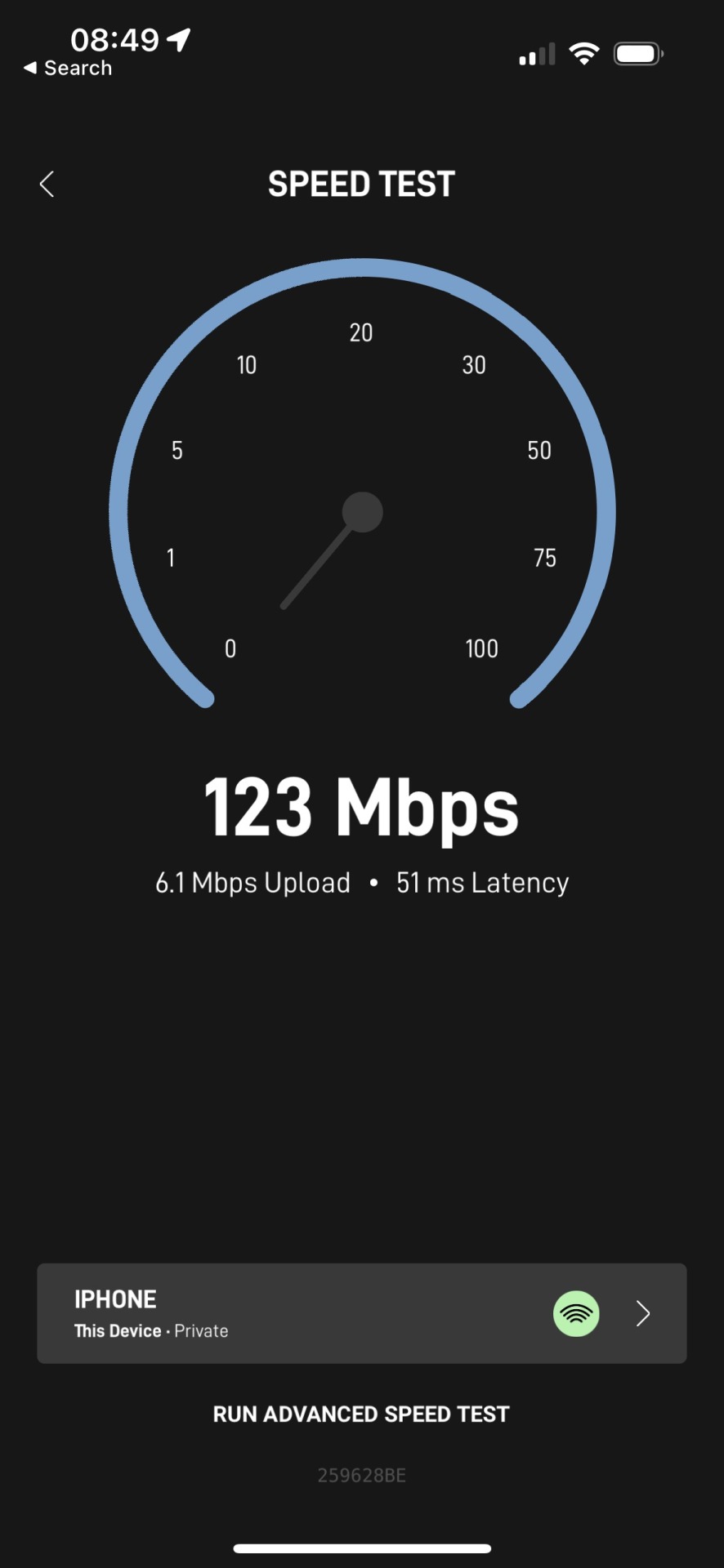
And the latency to google.com is eehhh, ok:

So why not another fiber or broadband provider?
I've been enjoying not paying Comcast too much
The Starlink dish was sitting in my closet
They're hobby projects, not payment processors that need 5+ 9s of availability and sub 10ms latency
(the primary line kinda never goes down anyway)
Off the griiiiidddd
etc.
Installation is a cinch if you cut corners:
Put it on the roof

Do a great job running and hiding the cables, definitely no eyesores here (not pictured)
(sorry to devon)
Through the wall and into the router
First time using this stuff to seal the hole drilled for the cable, plus some Sikaflex concrete sealant since, unlike regular silicone caulk, it can be painted once dried.
There may be an embarrassing part omitted here involving drilling into an "electrical wire", panicking, and in the end discovering that it was chicken wire & part of the stucco...
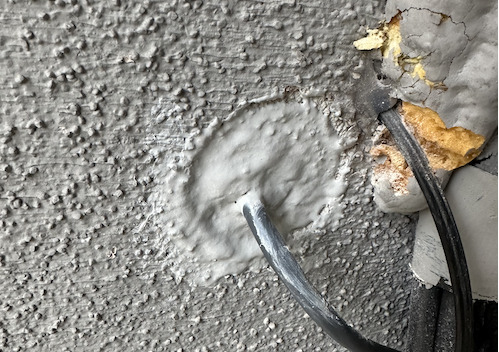
Not pictured: cable grommet for the 1" hole that has not yet arrived from Amazon

"That's a giant hole" Yeah, because of this thing :(
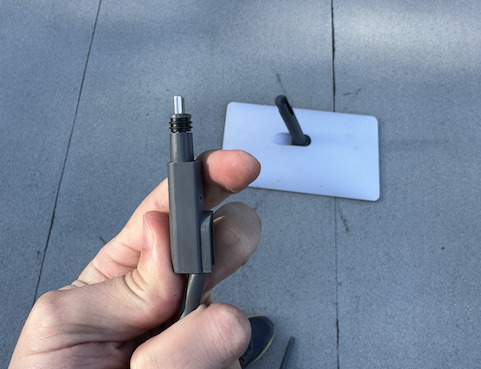
The official routing kit comes with a 3/4" drillbit. I used the 1" drillbit I had on hand.
Final result:
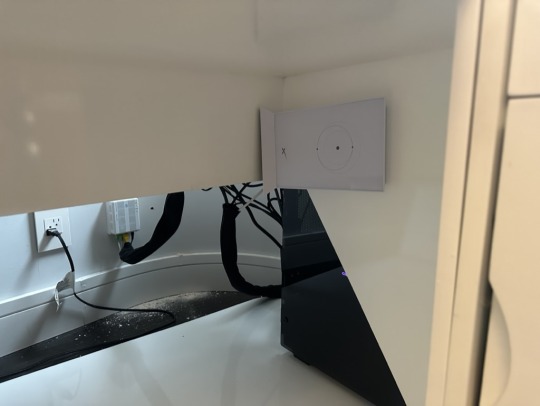
Step 2: Automated failover
At this point, I had a separate SSID that I could manually switch devices to, but I didn't want to have to deal with doing that manually when I'm away from home. And I might not always be available, and don't want users waiting until I am...
Enter the Ubiquiti Dream Machine (UDM) Pro!
Ok, so I really just copied a friend here without doing a ton of research:

But it ticks the boxes:
WAN failover (WAN load balancing not supported... but we can handle a few seconds of downtime)
Remote management interface
...That's it?
It does way more than this, but my goals are not lofty.
Once it arrived, it only took a few minutes for initial setup:
Plugged primary modem into WAN port 2, SFP+ 10gb (with an RJ-45 adapter)
Plugged Starlink router into WAN port 1 (with a Starlink ethernet adapter)
Turned on the UDM Pro, paired via bluetooth and finished guided setup through the iOS app
I then changed the port configuration to make WAN 2 primary and WAN 1 secondary. In my head this felt like a step toward >1Gb home Internet (AT&T offers 5 Gb today 😱). In practice, this led to a lot of packet loss and continual failovers to the backup link; it's probably an issue with the adapter or cable somewhere in the chain but i didn't feel like figuring it out.
I then discovered that you can configure port 8 as the secondary WAN link, and shuffled connections around so both WANs were cabled without the need for an adapter. This fixed the failover flapping and packet loss.
Somewhere along the way I also changed the echo server from the default Ubiquiti server to Google DNS (8.8.8.8). Ubiquiti pings the echo server to make the decision to fail over or not. I'm not sure this contributed to solving my issues, but it has for some
Success!

And kind of a sick name...
I didn't have to simulate failover because I broke things plenty of times during the setup process:
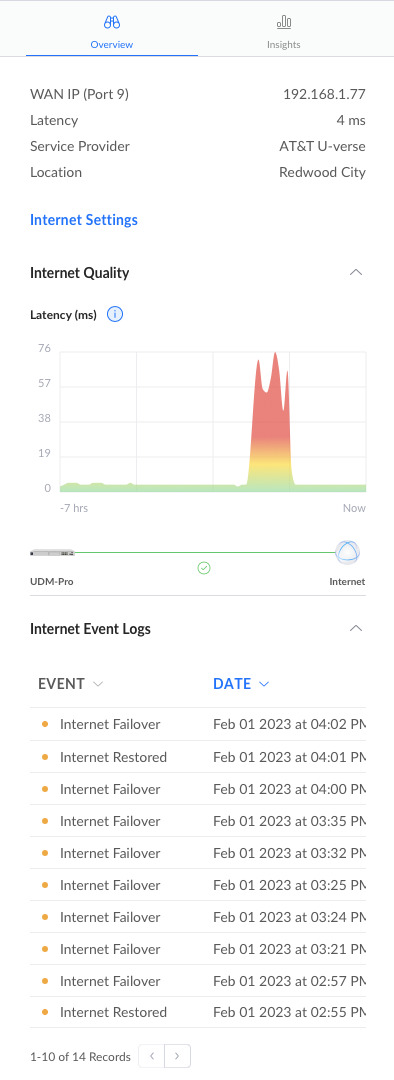
In practice, I saw 5-10 seconds of packet loss before Starlink took over. And automated recovery when AT&T started pinging again! More than adequate for users of a DDR BPM calculator.
What's left?
Ok, redundant power + Internet. But how do users get to a server deployed in my house when the IP changes on failover? Dynamic DNS? Do I go full Brad Fitzpatrick and shell out $12k+ on a /24 of IPv4 space, and create my own ASN + anycast from my house? (probably not) Am I going to deploy CRITICAL DANCE GAME SERVICES on a SINGLE DESKTOP MACHINE!? (obviously not) I don't know. Hopefully we will find out together in a subsequent post.
7 notes
·
View notes
Text
If you’re like me, you are completely dumbfounded when it comes to anything technological. Phones, computers, TV’s, and even setting up an Alexa device…
Well, I’m not totally lost! I know the basics. But has it ever occurred to anyone what TRULY goes into technology? The nitty and the gritty of it all? Until recently, I could care less to be quite frank. Let’s dive in!
Something not a lot of people know about is “bandwidth”. What is bandwidth? Great question! Bandwidth refers to the rate of data transfer your computer and other devices have access to, measured in bits per second. In simpler terms, bandwidth specifically refers to the capacity at which a network can transmit data. You’re probably wondering what bits per second is - I was lost about it too.
I mentioned something else that would form a decent question: what is a bit? A bit, abbreviated for binary digit, is the smallest unit of data that a computer can process and store. Because bits are sooo small, bandwidth speeds are usually referred to as kilobits (kilobyte), megabits (megabyte), or gigabits (gigabyte). Those words sound like a collection of Latin words all jumbled up to make sense. Well guess what, most languages are a collection of Latin words jumbled up! These three speeds are measured in quantities. A kilo is 1,000 bits, mega is 1,000,000 bits, and giga is 1,000,000,000 bits. That looks like a lot - but technology is so far advanced that luckily we don’t have to worry too much about what it actually means or is! However, bits and bytes are not the same. While a bit is the smallest unit of computer information representing either 1 or 0, bytes represents data storage.
Let’s get back to bandwidth. Bandwidth has two different processes taking place: upload and download. Uploading is the process of sending data from your devices to the internet whereas downloading is the process of retrieving data from the internet. It is essential to know your networks upload and download speed because rates can affect the quality of your productions whether it be live-streaming, creating music or other media, or even saving music to a device! The internet is so cool and filled with so much knowledge! Another cool thing about the internet is that you can check your bandwidth speed by simply using google!
Here are some examples of bandwidth to help you understand it! 1) An average electric guitar has a bandwidth of 80 hertz - 5 kilohertz, as the instrument cannot produce sounds above or below these frequencies. 2) The bandwidth of a network is 40 megabits per second, or Mbps. This implies that the network cannot transmit data faster than 40 megabits per second in any given case. Just like we are limited to certain things, technology is also limited - to a certain extent. Now let’s get into more networks that are closer to home for us, like Netflix! Netflix measures their bandwidth per hour, per device. If someone has the standard definition package, it uses up to 1 gigabytes which is equal to 1,000,000 bits. For a high definition package, it uses up to 3 gigabytes. For the ultra high definition package, or 4k, it uses up to 7 gigabytes. Apple Music is kind of the same as well. Apple Music uses 256 kilobits per second where as Spotify uses 320 kilobits per second. Who would’ve thought!
Now that you and I, whoever graces themselves with this wonderful blog of all things technical, have caught up on our lesson for the day (or night), I hope YOU have a wonderful night! Turn on your TV, listen to your music, and get your brains working. Now you know how bandwidth works! Arrivederci!
Sincerely, TheBareSphinx
2 notes
·
View notes
Note
I might be 5”0 but I can put some inches in you ;) - Gigabit
OH, I KNOW
1 note
·
View note
Text
Studies over and over and over again have shown that people WANT to pay for art. They have no problem whatsoever paying for movies, TV shows, music, books, games, etc.
So long as it's easy to use and reasonably priced.
Piracy rates fell dramatically for movies and TV as soon as Netflix and Hulu showed up with cheap prices and the ability to watch pretty much any movie or TV show you'd like between the two.
Then came HBOMax and Disney+ and Paramount+ and Peacockand Amazon Prime and every other streaming service that started fragmenting what shows and movies were available on what site. Then they all (including Netflix and Hulu) started raising their prices from around $5/mo to $10-25/mo along with so many more sites demanding subscription fees.
So now if I decide I want to watch a certain movie or show, I have to search on Google (or increasingly some other site because of the algorithmically "AI" generated clickbait misinformation) to find out which streaming service it's on.
Then I have to find it on that site with varying levels of frustration.
Then I have to deal with a streaming service in many cases that has no way to control the stream quality so even though I have a gigabit internet connection, I'm stuck watching the first 5 minutes of the show in 480p with no way to tell it I have the bandwidth to stream 4K.
Then I have to deal with the inability to screenshot anything if I want to talk about it on social media.
Then I have to deal with the volume mixing being terrible with the background sound effects drowning out dialogue because they master in 5.1 but don't properly downmix to stereo.
Then I have to hope this streaming service (if it's a TV show) autoplay the next episode properly (several do NOT) or if it's a movie franchise having all the sequels on the same service.
OR...theoretically, I could connect to a VPN, go to a piracy site, type in the name of the movie/show, click the magnet link, and download the entire film series/TV show in a couple of seconds. And I would then have a file playable in VLC which stays at the same resolution, doesn't lag, allows for audio filters so audio is properly balanced, allows for a playlist that properly advances to the next episode/film, has a built-in screenshot feature, and is basically an easier and more pleasant experience.
Now I would never admit to doing this because it is still admitting to a felony - so I definitely do NOT do this myself and never would - but you can understand why some people still pay for streaming services but pirate the shows from those services because it's far easier than dealing with all the hoops to watch them legally. And it also makes it very easy to justify canceling these services when they raise their prices or make some facepalm-worthy executive decision that turns an ongoing subscription into a moral choice.

yarrrrrrrrrrrrrrrrrrr you greedy fucks
122K notes
·
View notes
Text
Choosing the Best Spectrum-Approved Modem: A Guide to Faster Internet and Saving on Monthly Fees
If you are a spectrum consumer looking to optimize your Internet connection, choosing the right modem can truly make a world of a difference. Using spectrum approved modem can save you a lot of money on equipment rental fees, boost your connection speeds and provide great control over your home network. With the plenty of options available in this guide you can learn everything about SPECTRUM APPROVED MODEMS.

Why should you choose spectrum approved modem?
Just like Brightspeed Approved Modems spectrum approved model provides a list of devices compatible with the services ensuring that every element meets the technical requirements for speed reliability and compatibility. The modem is basically certified to deliver the best speed and stability for your subscribed plan. Owning the modem means you can avoid monthly rental fees charged by spectrum which can add up with time. And approved modem with updated features supports high speed and greater bandwidth making your network ready for future upgrades.
Understanding modem compatibility with spectrum
Spectrum provides a list of recommended modems for its plan on the website with specifications based on the specific elements. Data over cable service interface is a standard technology for cable modems. It is for most plans but for Gigabit speed plans you can go for a better version.
How to set up the spectrum approved modem?
Firstly, if you're replacing a spectrum rented modem disconnected from all the cables and powerful stuff now you need to attach the coxial cable to the modem plug it into the power source and connect it to the router if you are using a separate one. You can visit the self-installation active page on the website or call the customer service. You will need your account information for activation. You can run a speed test to ensure that you're getting the speeds that you're subscribed to. Adjust placement if you are using a combo device for better Wi-Fi coverage.
Benefits of owning your own spectrum approved modem
The spectrum charges monthly fees for rented equipment that is around 5 to $10. By owning the modem you can save on this expenses which can add up greatly with time. Having your own modem gives you more control over firmware updates and network settings. You can also reset the modem whenever required. Having your own modem gives you more control as you have the ability to choose that model that aligns perfectly with your speed needs.
So above all you need to know that owning a spectrum approved modem is a cost effective and performance enhancing option for you if you are wanting more control over your Internet speed.
For more details visit our website buyyourownmodem.com
#Brightspeed Approved Modems#VERIZON FIOS APPROVED MODEMS#CenturyLink Compatible Modems#XFINITY APPROVED MODEMS#SPECTRUM APPROVED MODEMS#CenturyLink Approved Modems#WINDSTREAM APPROVED MODEMS#TDS Approved Modems#Xfinity Tripleplay modem#Xfinity Docsis 3.1 Modem
0 notes